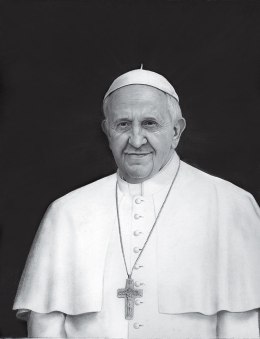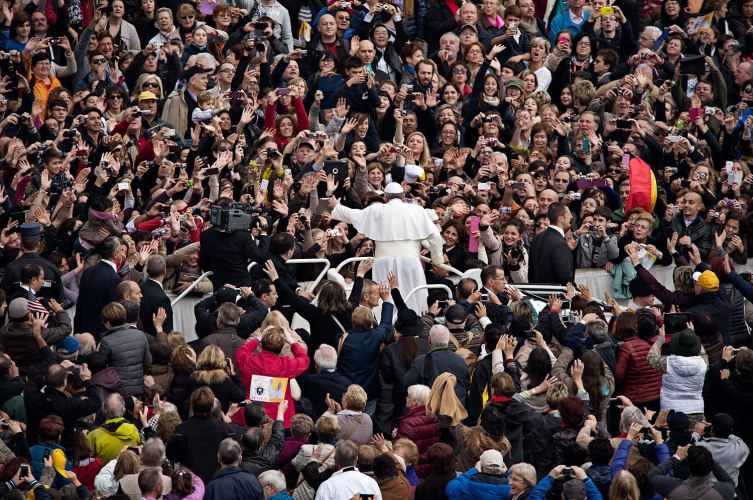
To read about TIME’s choice in Spanish and Portuguese, click below.
EL ELEGIDO: El Papa Francisco es la Persona del Año 2013 de TIME
A Escolha: O Papa Francisco é a Personalidade do Ano eleita pela Time em 2013
On the edge of Buenos Aires is a nothing little street called Pasaje C, a shot of dried mud leading into a slum from what passes for a main road, the garbage-strewn Mariano Acosta. There is a church, the Immaculate Virgin, toward the end of the pasaje—Spanish for passage—where, on one occasion, the local priest and a number of frightened residents took refuge deep in the sanctuary when rival drug gangs opened fire. Beyond the church, Pasaje C branches into the rest of the parish: more rutted mud and cracked concrete form Pasajes A to K. Brick chips from the hasty construction of squatter housing coagulate along what ought to be sidewalks. The word asesino—murderer—is scrawled in spray-paint on the sooty wall of a burned-out house, which was torched just days before in retaliation for yet another shooting. Packs of dogs sprawl beneath wrecked cars. Children wander heedless of traffic, because nothing can gather speed on these jagged roads. But even Pasaje C can lead to Rome.
As Cardinal and Archbishop of Buenos Aires, a metropolis of some 13.5 million souls, Jorge Mario Bergoglio made room in his schedule every year for a pastoral visit to this place of squalor and sorrow. He would walk to the subway station nearest to the Metropolitan Cathedral, whose pillars and dome fit easily into the center of Argentine power. Traveling alone, he would transfer onto a graffiti-blasted tram to Mariano Acosta, reaching where the subways do not go. He finished the journey on foot, moving heavily in his bulky black orthopedic shoes along Pasaje C. On other days, there were other journeys to barrios throughout the city—so many in need of so much, but none too poor or too filthy for a visit from this itinerant prince of the church. Reza por mí, he asked almost everyone he met. Pray for me.
When, on March 13, Bergoglio inherited the throne of St. Peter—keeper of the keys to the kingdom of heaven—he made the same request of the world. Pray for me. His letter of retirement, a requirement of all bishops 75 and older, was already on file in a Vatican office, awaiting approval. Friends in Argentina had perceived him to be slowing down, like a spent force. In an instant, he was a new man, calling himself Francis after the humble saint from Assisi. As Pope, he was suddenly the sovereign of Vatican City and head of an institution so sprawling—with about enough followers to populate China—so steeped in order, so snarled by bureaucracy, so vast in its charity, so weighted by its scandals, so polarizing to those who study its teachings, so mysterious to those who don’t, that the gap between him and the daily miseries of the world’s poor might finally have seemed unbridgeable. Until the 266th Supreme Pontiff walked off in those clunky shoes to pay his hotel bill.
The papacy is mysterious and magical: it turns a septuagenarian into a superstar while revealing almost nothing about the man himself. And it raises hopes in every corner of the world—hopes that can never be fulfilled, for they are irreconcilable. The elderly traditionalist who pines for the old Latin Mass and the devout young woman who wishes she could be a priest both have hopes. The ambitious monsignor in the Vatican Curia and the evangelizing deacon in a remote Filipino village both have hopes. No Pope can make them all happy at once.
(MORE: Behind the Pope Francis Cover)
But what makes this Pope so important is the speed with which he has captured the imaginations of millions who had given up on hoping for the church at all. People weary of the endless parsing of sexual ethics, the buck-passing infighting over lines of authority when all the while (to borrow from Milton), “the hungry Sheep look up, and are not fed.” In a matter of months, Francis has elevated the healing mission of the church—the church as servant and comforter of hurting people in an often harsh world—above the doctrinal police work so important to his recent predecessors. John Paul II and Benedict XVI were professors of theology. Francis is a former janitor, nightclub bouncer, chemical technician and literature teacher.
And behind his self-effacing facade, he is a very canny operator. He makes masterly use of 21st century tools to perform his 1st century office. He is photographed washing the feet of female convicts, posing for selfies with young visitors to the Vatican, embracing a man with a deformed face. He is quoted saying of women who consider abortion because of poverty or rape, “Who can remain unmoved before such painful situations?” Of gay people: “If a homosexual person is of good will and is in search of God, I am no one to judge.” To divorced and remarried Catholics who are, by rule, forbidden from taking Communion, he says that this crucial rite “is not a prize for the perfect but a powerful medicine and nourishment for the weak.”
Through these conscious and skillful evocations of moments in the ministry of Jesus, as recounted in the Gospels, this new Pope may have found a way out of the 20th century culture wars, which have left the church moribund in much of Western Europe and on the defensive from Dublin to Los Angeles. But the paradox of the papacy is that each new man’s success is burdened by the astonishing successes of Popes past. The weight of history, of doctrines and dogmas woven intricately century by century, genius by genius, is both the source and the limitation of papal power. It radiates from every statue, crypt and hand-painted vellum text in Rome—and in churches, libraries, hospitals, universities and museums around the globe. A Pope sets his own course only if he can conform it to paths already chosen.
And so Francis signals great change while giving the same answers to the uncomfortable questions. On the question of female priests: “We need to work harder to develop a profound theology of the woman.” Which means: no. No to abortion, because an individual life begins at conception. No to gay marriage, because the male-female bond is established by God. “The teaching of the church … is clear,” he has said, “and I am a son of the church, but”—and here he adds his prayer for himself—“it is not necessary to talk about those issues all the time.”
If that prayer should be answered, if somehow by his own vivid example Francis could bring the church into a new relationship with its critics and dissidents—agreeing to disagree about issues that divide them while cooperating in the urgent mission of spreading mercy—he might unleash untold good. “Argue less, accomplish more” could be a healing motto for our times. We have a glut of problems to tackle. Francis says by example, Stop bickering and roll up your sleeves. Don’t let the perfect be the enemy of the good—an important thing for the world to hear, especially from a man who holds an office deemed infallible.

Thousands turn out in Rome to greet Francis during his biweekly audiences.
See more photos of the Pope made for Person of the Year on LightBox .
A Changing Papacy
This papacy begins with a name. Jorge Bergoglio is the first Pope to choose as his namesake Francis of Assisi, the 13th century patron saint of the poor. The choice, coming after 14 Clements, 16 Benedicts and 21 Johns, is clearly and pointedly personal. The 13th century Francis turned to the ministry when, as legend has it, he heard a voice calling to him from a crucifix to repair God’s house. He left his prosperous silk-merchant family to live with the poor. He was a peacemaker, the first Catholic leader to travel to Egypt to try to end the Crusades. He placed mercy at the core of his life.
From that name follows much of Francis’ agenda. While the Catholic Church envisioned by Benedict XVI was one of tightly calibrated spiritual prescriptions, Francis told Father Antonio Spadaro, editor of the Jesuit magazine Civiltà Cattolica, in an interview published at the end of September, that he sees “the church as a field hospital after battle.” His vision is of a pastoral—not a doctrinaire—church, and that will shift the Holy See’s energies away from demanding long-distance homage and toward ministry to and embrace of the poor, the spiritually broken and the lonely. He expanded on this idea in a 288-section apostolic exhortation called “Evangelii Gaudium,” or “The Joy of the Gospel.” “I prefer a Church which is bruised, hurting and dirty because it has been out on the streets, rather than a Church which is unhealthy from being confined and from clinging to its own security,” he wrote. He made it clear that he does not just want talk—he wants actual transformation.
He has halted the habit of granting priests the honorific title of monsignor as a way to stem careerism in the ranks and put the focus instead on pastoring. He told a gathering of his diplomats that he wanted them to identify candidates for bishop in their home countries who are, he said, “gentle, patient and merciful, animated by inner poverty, the freedom of the Lord and also by outward simplicity and austerity of life.” To Francis, poverty isn’t simply about charity; it’s also about justice. The church, by extension, should not reflect Rome; it should mirror the poor.
Which helps explain why he has turned the once obscure Vatican Almoner, an agency that has been around for about 800 years and is often reserved for an aging Catholic diplomat, over to the dynamic 50-year-old Polish Archbishop Konrad Krajewski and told him to make it the Holy See’s new front porch. “You can sell your desk,” Francis told Krajewski. “You don’t need it. You need to get out of the Vatican. Don’t wait for people to come ringing. You need to go out and look for the poor.” The Archbishop hands out small amounts to the needy, including a recent gift of 1,600 phone cards to immigrant survivors of a capsized boat so they could call family back in Eritrea. Francis often gives Krajewski stacks of letters with his instructions to help the people who have written to him and asked for aid. In what sounds like a necessary precaution, the Vatican recently issued a denial after Krajewski hinted that Francis himself sometimes slips out of the Vatican dressed as an ordinary priest to hand out alms.

